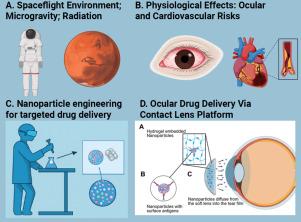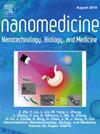微重力下先进的眼部给药:纳米治疗在心血管和眼科的应用。
IF 4.6
2区 医学
Q2 MEDICINE, RESEARCH & EXPERIMENTAL
Nanomedicine : nanotechnology, biology, and medicine
Pub Date : 2025-07-11
DOI:10.1016/j.nano.2025.102845
引用次数: 0
摘要
长期的太空任务严重影响宇航员的健康,导致各种系统和眼部疾病。眼表特别容易受到航天器内独特环境的影响。这通常会导致病理问题,如辐射诱发的加速动脉粥样硬化(RIAA)、航天相关神经眼综合征(SANS)和航天相关干眼综合征(SADES)。虽然传统的SADES治疗方法,如人工泪液和润滑剂,可以提供短期缓解,但它们可能会在长时间的太空飞行中失去效果。在这种情况下,纳米医学为包括药物和生物制剂在内的治疗药物的控制和靶向递送提供了有希望的解决方案。本综述评估了宇航员眼部健康和心血管变化的范围,强调了现有治疗措施的局限性,并探讨了基于纳米技术的方法如何通过显著增强微重力下的药物输送来克服这些局限性。我们进一步讨论了严格验证的必要性,以改善未来空间探索中眼和心血管的管理。本文章由计算机程序翻译,如有差异,请以英文原文为准。

Advanced ocular drug delivery in microgravity: Nanotherapeutic applications as cardiovascular and ophthalmic countermeasures
Extended space missions significantly affect astronaut health, leading to various systemic and ocular conditions. The ocular surface and cardiovascular system are particularly susceptible to the unique environment within the spacecraft. This can often lead to pathologic issues such as radiation-induced accelerated atherosclerosis (RIAA), spaceflight-associated neuro-ocular syndrome (SANS) and spaceflight-associated dry eye syndrome (SADES). While traditional treatments for SADES, such as artificial tears and lubricants, provide short-term relief, they may lose effectiveness during long-duration spaceflight. In this context, nanomedicine offers promising solutions for the controlled and targeted delivery of therapeutics, including drugs and biologics. This review assesses the spectrum of ocular health and cardiovascular changes in astronauts, highlights the limitations of existing therapeutic measures, and explores how nanotechnology-based approaches can overcome these limitations by significantly enhancing drug delivery in microgravity. We further discuss the need for rigorous validation to improve the management of ocular and cardiovascular in future space exploration.
求助全文
通过发布文献求助,成功后即可免费获取论文全文。
去求助
来源期刊
CiteScore
11.10
自引率
0.00%
发文量
133
审稿时长
42 days
期刊介绍:
The mission of Nanomedicine: Nanotechnology, Biology, and Medicine (Nanomedicine: NBM) is to promote the emerging interdisciplinary field of nanomedicine.
Nanomedicine: NBM is an international, peer-reviewed journal presenting novel, significant, and interdisciplinary theoretical and experimental results related to nanoscience and nanotechnology in the life and health sciences. Content includes basic, translational, and clinical research addressing diagnosis, treatment, monitoring, prediction, and prevention of diseases.

 求助内容:
求助内容: 应助结果提醒方式:
应助结果提醒方式:


